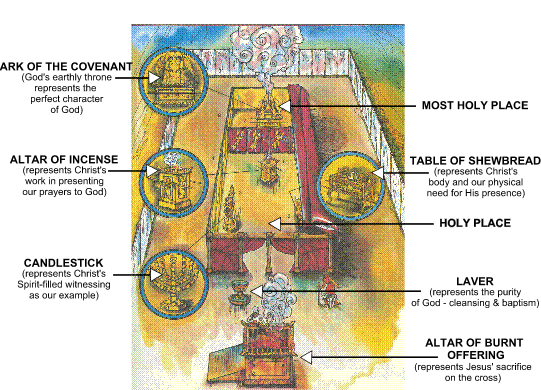The Bible says that God's "WAY" is in the Sanctuary. This
text gives us a glimpse of just how vital the study of the Sanctuary is to
Spiritual growth. God's "WAY" has to do with His character. Psalm 18:30 -
"As for God, His WAY is perfect..." It is through understanding God's WAY
that we come to love Him.
In fact, it is so essential for us to KNOW God in this
intimate fashion, Jesus came to show us God's WAY. John 14:6 - "Jesus
saith unto him, 'I am the WAY, the truth, and the life: no man cometh unto
the Father, but by Me.'
Each part of the Sanctuary was designed to be a visual
illustration of the plan of salvation and the character of God. It
exemplifies the beauty of Jesus. For this reason, it is essential when
studying salvation, to view it within the lovely context of the
Sanctuary...
|

|
 |
| ALTAR OF BURNT OFFERING | LAVER | CANDLESTICK |
|
The first thing a sinner
saw upon entering the courtyard of the sanctuary
was the "altar of burnt offering". On this, the
priests sacrificed all the offerings brought to them
by the people each day (see Exodus 27). Both the
sacrifices and the altar itself pointed to Christ
Who sacrificed His own life so that repentant
sinners might live and find peace with God.
|
Before the priest could offer any sacrifice
upon the altar of burnt offering, he had to first wash
his hands in the laver (See Exodus 30:17-21). This showed
that God required purity and cleanliness from those who
mediated between Him and His people. Because Christ alone
among men has epitomized the purity God requires of a
mediator, He alone can truly mediate for fallen man.
|
Against the south wall of the holy place
stood a golden candlestick with seven lamps. At least one
of the lamps was always lighted. Each morning and evening
the high priest trimmed and lit the lamps and replenished
the oil which they burned (See Exodus 37:17-23; 30:7,8)
The candlestick represented both Christ and His people -
all who convey the light of truth. Those whose hearts are
set aflame by the oil of the Holy Spirit bless others
and act as lights to them.
|
|
|
|
|
 |
| ALTAR OF INCENSE | TABLE OF SHEWBREAD | ARK OF THE COVENANT |
|
Each morning and evening, the priests
took coals of fire from the altar of burnt offering
and placed them on a small altar before the veil
which separated the holy place of the sanctuary
from the most holy place. They then placed incense
on these coals so that smoke ascended and filled
the two apartments (See Exodus 30:1-10). This
represented the work of Christ as He presents the
prayers of His people before God mixed with His
own righteousness.
|
Against the north wall of the holy place
stood a small table, upon which the priests placed
bread each Sabbath. Each week, the priests ate the old
bread and placed new loaves on the table. This bread
was called "shewbread" or "bread of the presence," because
it remained before the presence of the Lord
(See Exodus 25:23-30). It represented Christ, Who is
ever in the presence of God for us. Just as surely
as we need food to live, so we need Christ, "the
Living Bread".
|
In the Most Holy Place stood a golden
ark. It housed two pieces of stone upon which God had
written His law with His own finger. The "mercy seat",
a golden lid which sat upon the ark, covered the law.
At each end of the mercy seat stood the figure of an
angel bowing in adoration (See Exodus 25:10-22). The
ark, combining as it did visual expressions of God's
law and His mercy, represented the very character of
God, for in Him justice and mercy meet. Just as the
Jews turned their attention to the most holy place
on the Day of Atonement, so just before Christ returns
to this earth, God directs the attention of His
people to the ark in the most holy place of the heavenly
sanctuary.
|
|
|
|
|
| .::top::. |
|
|

